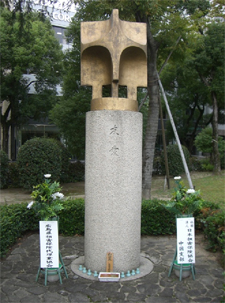
Date of completion
August 3, 1965
Established by
The General Insurance Association of Japan Hiroshima Local Committee
Designers
Sculpture by Shindo Tsuji (then professor of Kyoto City University of Arts)
Footstone by Yutaka Iwasaki (then worker of Iwasaki Marble Stone Kogyo Co., Ltd.)
Shape
The monument, comprising a bronze sculpture and a footstone made of Mannari granite, is cruciform in shape to represent people from north, south, east and west, holding hands to express the linkage through love and conscience of people all over the world who wish for peace. The monument, which is 3.3 m high, is prayed to by people from all over the world for the repose of A-bombing victims' souls.
Motive for the erection
The monument was built to console the souls of 89 A-bombing victims of the member companies of the General Insurance Association of Japan and to pray for the foundation of peace.
Epigraph
"Yuai" (meaning friendship), (Calligraphic characters by Mikio Takagi, president of the General Insurance Association of Japan)
Noteworthy characteristics
- A-bombing Victims
- A-bombing and War Insurance
- Epitaph as Memorial Monument
At the time of the A-bombing, many general insurance companies were located near the present-day Peace Memorial Park. Since the business hours of those companies began at 8:30 a.m., many workers were exposed to radiation either in or on their way to their offices, or were missing. Of the approximately 200 workers of those insurance companies, 79 had passed away by December of that year.
Immediately after the outbreak of the Pacific War, the Japanese Government promulgated the Special War Insurance
Measures Law and established war insurance that could compensate for damage from fires and destruction stemming from battle actions. In the beginning, only a few people applied for the insurance, because citizens did not expect to be bombed in air-raids and the insurance did not guarantee immediate payment, in principle. In April 1944, these insurance companies became extremely busy on consecutive days because of the facts that the war-time special insurance law took effect and the special insurance became compulsory collateral insurance when buying fire insurance, and that citizens of Hiroshima City began applying for the insurance all at once due to the commencement of air-raids on big cities.
After the A-bomb was dropped, in order to ease people's apprehension the insurance was immediately paid at the joint payment office of all insurance companies, established on around August 10 in the Bank of Japan, which had survived the fires.
Considering the future of Hiroshima, the monument was created with an abstract design and inscribed with the characters "Yuai" (meaning friendship) as an epitaph to familiarize the monument with the public, rather than simply to serve as a gravestone.
The tribute, with the phrase meaning "This statue is respectfully dedicated to the repose of the souls of A-bombing victims involved in the insurance companies. August 3, 1965. By the General Insurance Association of Japan Hiroshima Local Committee," the victims' names were inscribed on copper plate and sealed in a copper box, which is embedded in the joint between sculpture and footstone.